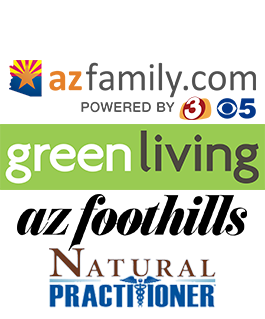
As summer approaches, it is more important than ever to protect our skin from the damaging UV rays of the sun. There is a lot of information out there on the risks and benefits of sunscreen ingredients. This includes research that certain sunscreen ingredients may lead to hormonal imbalances, as well as other consequences. So if we want to make sure our skin and hormones are healthy, what is the best choice?
First let’s chat about why it’s so important to use sun protection. The sun emits UV radiation in three forms, two of which reach us (UVA and UVB). UVA causes DNA damage resulting in increased appearance of aging and pigmentation of the skin. UVB is what causes sunburns and breaks in our DNA, which has infamously become associated with nonmelanoma skin cancer. Unfortunately for us, the amount of UVB that is blocked by the ozone layer is continually getting smaller, making our protective methods all the more important.
What About Getting Sun for Vitamin D?
The reason some people don't wear sunscreen is that they don't want to block their Vitamin D production. While, yes, Vitamin D is very important and deficiency is common, which is why some unprotected sun exposure is a good thing. A study out of Switzerland suggested that on average during the spring and summer people could synthesize 1,000IU of vitamin D per 10-15 minutes of sun exposure with at least 22% of the skin being uncovered. Small sessions of sun exposure like this may be helpful in promoting production of vitamin D while minimizing the negative effects.
Chemical vs Physical Sunscreens:
There are two different types of sunscreen: chemical and physical. Chemical sunscreens function by absorbing the UV rays and converting it into heat energy to reduce the effects. Many of the mainstream sunscreen brands utilize these as their active ingredients. Physical sunscreens function primarily through scattering and reflecting the UV radiation from the skin’s surface.
So why would you choose one over the other? The chemical sunscreens may result in disruptions to our hormonal systems. Main ingredients used in chemical sunscreen have been identified to have endocrine-disrupting properties that could influence our hormones by interfering with our Hypothalamic-Pituitary-Ovarian axis and Hypothalamic-Pituitary-Thyroid axis.
Ingredients to avoid:
With all the marketing strategies out there trying to get you to buy their products, it’s always best to look at the ingredients yourself to decide if it’s safe for you. When looking at sunscreens, here are a list of active ingredients to avoid according to the EWG:
Ingredients to look for:
So how do we spot a physical sunscreen? Thankfully, it's relatively easy to decipher the two. Physical sunscreen will have one of two active ingredients:
When looking at the inactive ingredient list, you’ll want to preferentially choose ones that contain things such as natural oils (i.e. avocado oil, shea butter, etc.) which help to emulsify and aid in application of the sunscreen in addition to soothing the skin.
The Importance of Covering Up:
While sunscreen is a necessity when being outside for long periods of time, adding in some extra sun coverage such as hats and other protective clothing can help to manage skin damage even further. It’s also important to note that even if there is some cloud cover and the sun is not entirely visible, it does not mean you’re safe from UV radiation exposure. In fact, while most cloud cover reduces UV rays, there are circumstances in which they can actually enhance them, increasing the amount that we are being exposed to.
Where to Find Hormone Safe Sunscreen:
While it may feel like chemical sunscreens dominate the market, there are a large array of options for those of us seeking a more hormone-friendly option. Keeping an eye out for ingredients is always going to be important, but if you’re looking for a list of sunscreens that are considered hormone safe, the EWG can get you started. The EWG’s Skin Deep website and phone application can be valuable in your search.
While hormone protection is all about consistency and reduction of exposure, there may be times where you find yourself in a pinch and only have access to chemical sunscreens. That is okay. You should never skip out on sunscreen even in these cases as the reduction of sun damage to your skin far outweighs a single day’s use of chemical sunscreen. The function of this article is not to daemonize sunscreen when it’s needed, but hopefully to help empower you to choose options that are safe for both your skin, and your hormones.
Resources:
Located within: Blog.
Have a question or need to schedule an office visit?
Please fill out the form below or call 480.771.4422.
have you seen us?

8952 E Desert Cove Ave, Ste 208. Scottsdale, AZ 85260
© 2025 Natural Kid Doc, Dr. Kiera Smialek ND, FABNP
all rights reserved. privacy policy